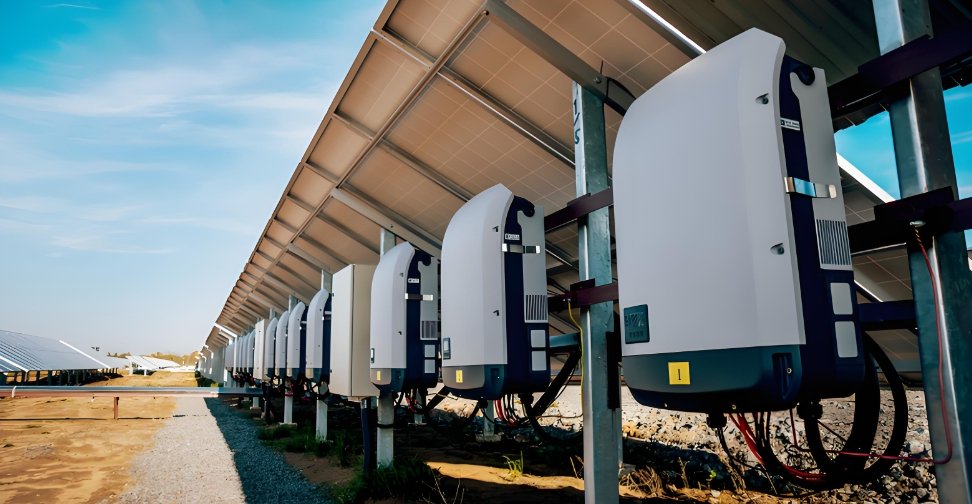An inverter plays a crucial role in integrating solar power generation and energy storage, ensuring that your solar energy system operates efficiently. This article will explore how inverters work with solar panels and batteries to maximize energy use.
Inverters convert solar power, manage battery charging and discharging, and ensure efficient energy flow between components. Learn how the right inverter can optimize your solar system’s performance.
Curious about how inverters integrate with solar panels and batteries? Read on to understand their key functions and how to make the most of your solar energy system.
How Does an Inverter Convert Solar Power for Use in Homes or Businesses?
The primary function of an inverter is to convert the DC (direct current) electricity generated by solar panels into AC (alternating current) electricity, which is the form of power used by most household appliances and business equipment.
The inverter is a critical link between solar panels and your home or business, ensuring that the energy generated by your solar system can be utilized efficiently.
Solar Panel Power Generation
Solar inverters1 are essential for transforming the DC electricity generated by solar panels when exposed to sunlight. The amount of energy produced depends on factors such as the size of the solar panel system, geographic location, and time of day.
Conversion to AC Power
The inverter takes the DC power from the solar panels and converts it into AC power using a process called "inversion." DC to AC conversion2 ensures that this happens seamlessly and efficiently, providing a constant and reliable supply of electricity for your appliances.
Grid Connection or Self-Consumption
Once the inverter converts DC to AC, it can either supply electricity to the grid (in grid-tied systems) or directly power your appliances (in off-grid or hybrid systems). In a hybrid system, the inverter also manages energy storage and use from batteries.
| Process | Description |
|---|---|
| Solar Panel Generation | Solar panels produce DC electricity |
| Power Conversion | The inverter converts DC to AC for home or business use |
| Grid or Self-Consumption | AC electricity is used by appliances or sent to the grid |
What Role Does the Inverter Play in Managing Battery Charging and Discharging?
In addition to converting solar power, the inverter also manages the charging and discharging of the battery, ensuring optimal energy storage and use.
The inverter’s battery management system (BMS) ensures that the battery is charged properly and discharges only when necessary.
Battery Charging
When the solar panels produce excess energy that is not immediately needed for consumption, the hybrid inverter3 directs this surplus energy to charge the battery. The inverter monitors the battery's charge level and ensures that the battery is charged safely and efficiently, preventing overcharging.
Battery Discharging
When the solar power generation is insufficient (e.g., at night or on cloudy days), the inverter discharges energy from the battery to provide power to the home or business. The Battery Management System (BMS)4 ensures that the battery discharges at an appropriate rate, maintaining a balance between energy supply and battery health.
Protection and Safety
The inverter’s BMS protects the battery from deep discharging or overcharging, both of which can shorten the battery’s lifespan. It also ensures that the system operates within safe voltage and current limits, preventing damage to the battery or the inverter itself.
| Function | Description |
|---|---|
| Charging | Inverter directs excess energy to charge the battery |
| Discharging | Inverter draws energy from the battery when solar is insufficient |
| Protection | BMS ensures safe charging and discharging rates |
How Does the Inverter Ensure Efficient Energy Flow Between Solar Panels and Batteries?
The inverter plays a vital role in ensuring that energy flows efficiently between the solar panels, the battery, and the load (appliances or the grid).
By managing the energy flow intelligently, the inverter maximizes the efficiency of both energy production and storage.
Energy Flow Management
The hybrid inverter continuously monitors energy production from the solar panels, energy storage in the batteries, and energy usage in the home or business. It then optimizes the flow of energy by:
- Sending excess energy to the battery for storage when the energy demand is low.
- Drawing from the battery when solar production is insufficient to meet demand.
- Supplying energy to the grid (if applicable) when there is excess power beyond the system’s needs.
Maximum Power Point Tracking (MPPT)
Most modern inverters use MPPT technology5, which ensures that the solar panels are always operating at their maximum power output. MPPT dynamically adjusts the inverter's operating point to match the solar panels' output, accounting for changing sunlight conditions throughout the day. This increases the overall efficiency of the system.
Preventing Energy Wastage
By managing the energy flow efficiently, the inverter minimizes wasted energy and ensures that the battery is always charged when needed. It also ensures that the battery discharges only when necessary, preserving its health and maximizing its useful life.
| Process | Description |
|---|---|
| Energy Flow Management | Inverter manages energy between solar, battery, and load |
| MPPT | Ensures solar panels operate at maximum efficiency |
| Preventing Wastage | Inverter prevents energy waste and optimizes battery use |
How Can You Optimize Your Solar System’s Performance with the Right Inverter?
The performance of your solar system can be significantly optimized by selecting the right inverter and ensuring it is set up and maintained correctly.
The right inverter can maximize energy production, improve battery storage efficiency, and reduce energy costs.
1. Choose an Efficient Inverter
Look for inverters that offer high efficiency6 (typically above 95%) and features like MPPT. The more efficient the inverter, the more energy it can convert and store for use. Inverters with higher efficiency will ensure that less energy is lost during the conversion process.
2. Match Inverter Capacity with Solar System Size
Ensure that the inverter is appropriately sized to handle the power output of your solar panels. [Matching inverter capacity](What is the importance of matching inverter capacity with solar panel size?)7 is critical to prevent wasted energy and ensure optimal system performance. An undersized inverter won’t process all the generated energy, while an oversized one may reduce system efficiency.
3. Proper Battery Sizing
Ensure that your battery storage is sized correctly for your system. A properly sized battery will allow the inverter to manage the energy flow efficiently, storing enough excess energy for use during low production times.
4. Regular Maintenance and Monitoring
Perform regular system maintenance, including cleaning the panels, checking inverter settings, and monitoring battery health. Many modern inverters come with smart monitoring capabilities, allowing you to track the performance of your solar system in real-time and make adjustments as needed.
| Optimization Tip | How to Maximize Efficiency |
|---|---|
| Efficient Inverter | Choose an inverter with high efficiency and MPPT |
| Match Inverter Capacity | Ensure inverter is correctly sized for your panels |
| Proper Battery Sizing | Match battery capacity to energy consumption needs |
| Regular Maintenance | Clean panels, check settings, and monitor system performance |
Conclusion
Inverters play a vital role in integrating solar power generation with battery storage, ensuring efficient energy conversion, management, and storage. By choosing the right inverter, optimizing your solar system’s configuration, and maintaining the system regularly, you can maximize the performance of your solar energy system, reduce reliance on the grid, and achieve long-term energy savings.
Footnotes:
-
Solar inverters play a key role in converting the DC power generated by solar panels into usable AC electricity for homes and businesses. ↩
-
DC to AC conversion is essential for ensuring that solar power can be used by standard appliances and integrated into the grid. ↩
-
Hybrid inverters manage energy flow between solar panels, batteries, and appliances, ensuring efficient charging and discharging of batteries. ↩
-
Battery Management System (BMS) protects batteries from overcharging or deep discharging, optimizing their lifespan and safety. ↩
-
MPPT technology ensures that solar panels produce maximum energy by dynamically adjusting to changing sunlight conditions. ↩
-
High inverter efficiency minimizes energy loss during conversion, ensuring maximum energy output from your solar panels. ↩
-
Matching inverter capacity with solar panel output prevents energy waste and ensures the inverter operates efficiently. ↩








